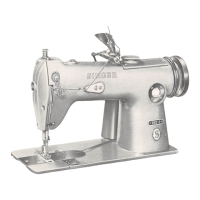SETTING
THE
STATIONARY
NEEDLE
GUARD
When
needles
and loopers ore correctly
set
in re
lation to each other, they should
pass
One
another as
closely as possible without touching.
Function of
stationary
needle
guard Is to prevent
needles
from
being sprung into path of loopers when
loopers ore on forward
stroke.
Check
needles
to
see
that
they are not bent, worn
or damaged.
NOTE: On two
and
three
needle
machines,
all
needles
should be the same
distance
from
needle
guard.
To adjust, loosen screw A, Fig. 25 and turn machine
pulley over toward operator until needle reaches Its
lowest point.
Position needle guard as
close
to needle as is
possible,
without
contacting
needle.
Tighten Screw A.
To adjust needle guard to clear feed dog, loosen
screw B, Fig. 25 and move
needle
guard to right or
left. Tighten screw B.
To adjust needle guard height to allow needle thread
loop to be formed correctly, loosen screw C, Fig. 25
and raise or lower needle guard as
may
be required.
Tighten screw C.
SETTING
THE
LOOPERS
FOR
TIMING
Turn machine pulley over toward operator until
loopers are at end of backward stroke (at extreme right
position).
Loosen clamping screw on looper ball crank arm as
shown in
Fig.
26.
Rotate ball crank arm to right or left In order to
position looper point approximately 9/64 inch
from
centerline
of
needle,
as shown in
Fig.
27.
Securely tighten clamping screw.
NEEDLE
GUARD
SCREW
B
SCREW
A-7=7^
mm.
SCREW
C
Fig. 25. Setting the Needle Guard
f®©l
1
IWJ-
©I
CLAMPING
SCREW
BALL
CRANK
ARM
Fig.
26*
Setting the Loopers for Timing
9/64"
Fig. 27. Looper Point 9/64 inch
from
Needle

